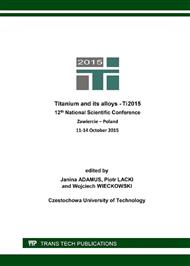p.41
p.47
p.55
p.65
p.71
p.79
p.87
p.92
p.98
Influence of Adopted Heat Treatments on Properties of Tri-Layer Composite AA2519 – AA1050 – Ti GR.5 Made by Explosive Cladding Method
Abstract:
The article shows the results of research on tri-layer composite AA2519-AA1050-Ti Gr. 5 made by explosive cladding method. Performed bond was heat treated in different conditions. Four specimens were heated in 530°C in 30 minutes, and after adopted different ways of cooling for each specimen. Used cooling in air and water. Additionally two specimens were aged at 150°C for 600 minutes. Last joint was heated at 420°C for 60 minutes and after was cooled in still air. For obtained joint were performed mechanical and technological tests. Tests included tensile strength test, yield strength test, ram strength test and bend test. Moreover performed structural tests, analysis of the chemical composition and hardness measurements. Based on the results evaluated the quality of joint, and described the influence of heat treatment on the properties of obtained multilayer material. Was found that as a result of explosive cladding, hardness in the interface increased. Heat treatments at temperature 530°C do not change properties. Only the heat treatment at temperature 420°C is decreasing hardness in the interface and in the whole cross section of the AA2519 layer.
Info:
Periodical:
Pages:
71-78
Citation:
Online since:
April 2016
Authors:
Keywords:
Price:
Сopyright:
© 2016 Trans Tech Publications Ltd. All Rights Reserved
Share:
Citation:


